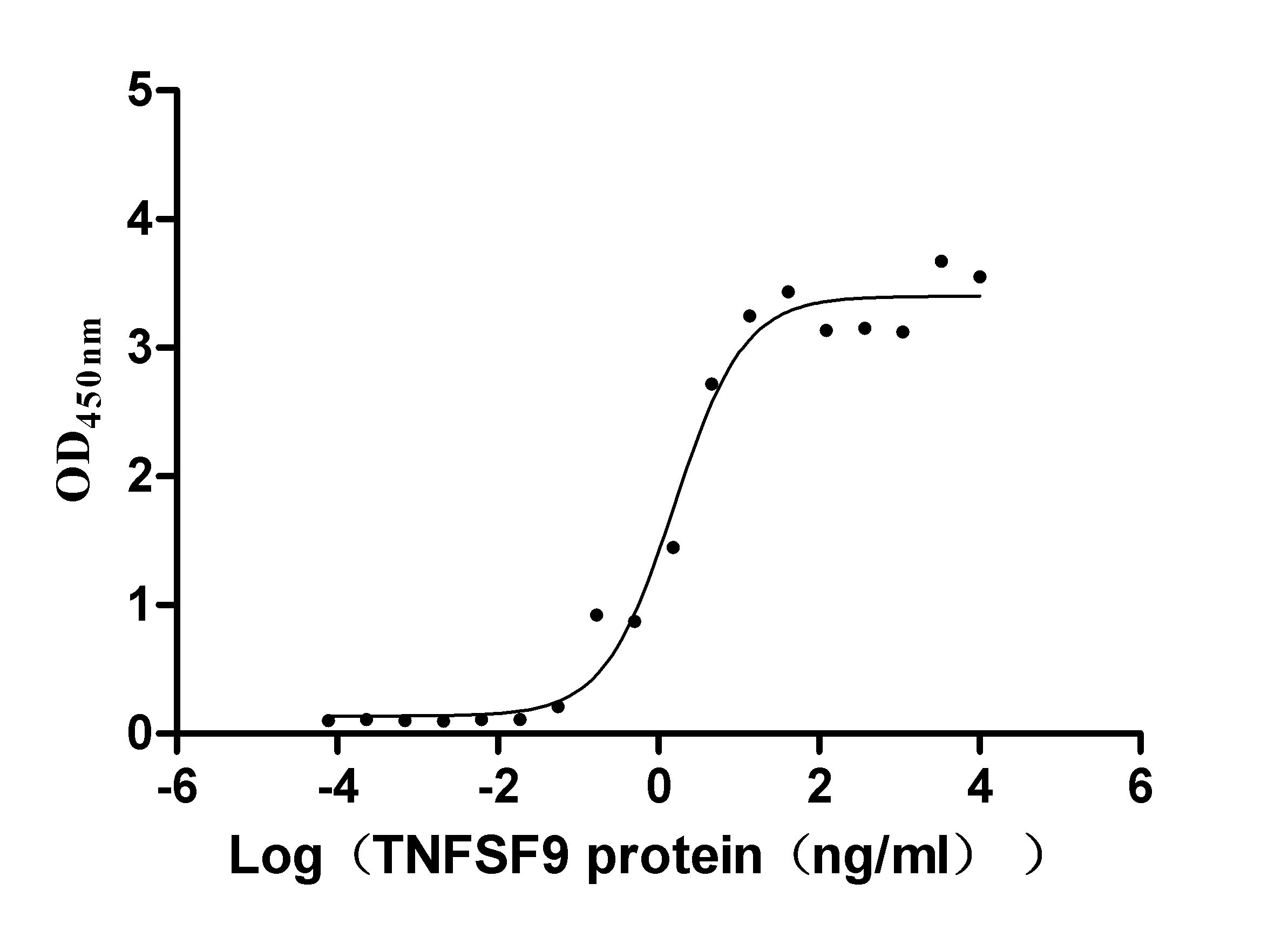Recombinant Mouse E3 ubiquitin-protein ligase DTX3L (Dtx3l)
-
货号:CSB-YP664947MO
-
规格:
-
来源:Yeast
-
其他:
-
货号:CSB-EP664947MO
-
规格:
-
来源:E.coli
-
其他:
-
货号:CSB-EP664947MO-B
-
规格:
-
来源:E.coli
-
共轭:Avi-tag Biotinylated
E. coli biotin ligase (BirA) is highly specific in covalently attaching biotin to the 15 amino acid AviTag peptide. This recombinant protein was biotinylated in vivo by AviTag-BirA technology, which method is BriA catalyzes amide linkage between the biotin and the specific lysine of the AviTag.
-
其他:
-
货号:CSB-BP664947MO
-
规格:
-
来源:Baculovirus
-
其他:
-
货号:CSB-MP664947MO
-
规格:
-
来源:Mammalian cell
-
其他:
产品详情
-
纯度:>85% (SDS-PAGE)
-
基因名:
-
Uniprot No.:
-
别名:Dtx3l; BbapE3 ubiquitin-protein ligase DTX3L; EC 2.3.2.27; Protein deltex-3-like; RING-type E3 ubiquitin transferase DTX3L
-
种属:Mus musculus (Mouse)
-
蛋白长度:Full Length of Mature Protein
-
表达区域:2-748
-
氨基酸序列ASSPDPPSP LLVRLRESIP KAHRKLEIYF QSRASGGGEC SVQPVGPSAP DTYEVKFLKK ADKEKVLKKS EHEMLVHNKP VTIVLETTKK PVEDLRPRLP SLTQPVETPS SRPPSLTGSL DEALCDDIHP QDGLVSNSVD SVVQKIFLAV TAELNCDLLS KEQRASITTV CPHIIKSMEG SDGIKKVCGN FKDIEKIHHF LSEQLLEREQ KRKGSEQKRK CAPQKHTPPD VEREPPDQSS IQVPVLLLEY FKHVNPGRLE FIEYKFGVNI EIQASSPNMV TVGFTSSPFG NVEEASQSFV RDFQKCSQSL KQDCISLEEH QRAKEVRQEL SRCFPKLLIK GQGRTLTLLG SPADISAATE KVSQGLGLRP VKITASGYTT GIEVDSTRFK LLEPELLQEI SEIEQKFNTR GKVQEKGQKT CILFVPKDKD LDLSVQSYTG FTDAFQRATW QLRTEVLSLK GLGKERARLH NTKFADNFKK EHPNVHFVTS QESVTLTGLP HHLAQAMQYV SKRMGLAPSS GEKLAMDQET PMEISSSDPH GDQQENAALP APRGTSSSPA ASKGTEDYCV ICMDTISNKH VLPKCKHEFC TSCISKAMLI KPVCPVCLTS YGIQKGNQPE GTMSYSTQKG SLPGYEGCGT IVINYEIKDG IQTKEHPNPG KAYHGTRRTA YLPDNTEGRK VLDLLHEAFK HRLTFTIGYS RATGVSDVIT WNDIHHKTSK FGGPANFGYP DPDYLKRVKE ELKAKGIE
-
蛋白标签:Tag type will be determined during the manufacturing process.
The tag type will be determined during production process. If you have specified tag type, please tell us and we will develop the specified tag preferentially. -
产品提供形式:Lyophilized powder
Note: We will preferentially ship the format that we have in stock, however, if you have any special requirement for the format, please remark your requirement when placing the order, we will prepare according to your demand. -
复溶:We recommend that this vial be briefly centrifuged prior to opening to bring the contents to the bottom. Please reconstitute protein in deionized sterile water to a concentration of 0.1-1.0 mg/mL.We recommend to add 5-50% of glycerol (final concentration) and aliquot for long-term storage at -20℃/-80℃. Our default final concentration of glycerol is 50%. Customers could use it as reference.
-
储存条件:Store at -20°C/-80°C upon receipt, aliquoting is necessary for mutiple use. Avoid repeated freeze-thaw cycles.
-
保质期:The shelf life is related to many factors, storage state, buffer ingredients, storage temperature and the stability of the protein itself.
Generally, the shelf life of liquid form is 6 months at -20°C/-80°C. The shelf life of lyophilized form is 12 months at -20°C/-80°C. -
货期:Delivery time may differ from different purchasing way or location, please kindly consult your local distributors for specific delivery time.Note: All of our proteins are default shipped with normal blue ice packs, if you request to ship with dry ice, please communicate with us in advance and extra fees will be charged.
-
注意事项:Repeated freezing and thawing is not recommended. Store working aliquots at 4°C for up to one week.
-
Datasheet :Please contact us to get it.
靶点详情
-
功能:E3 ubiquitin-protein ligase which, in association with ADP-ribosyltransferase PARP9, plays a role in DNA damage repair and in interferon-mediated antiviral responses. Monoubiquitinates several histones, including histone H2A, H2B, H3 and H4. In response to DNA damage, mediates monoubiquitination of 'Lys-91' of histone H4 (H4K91ub1). The exact role of H4K91ub1 in DNA damage response is still unclear but it may function as a licensing signal for additional histone H4 post-translational modifications such as H4 'Lys-20' methylation (H4K20me). PARP1-dependent PARP9-DTX3L-mediated ubiquitination promotes the rapid and specific recruitment of 53BP1/TP53BP1, UIMC1/RAP80, and BRCA1 to DNA damage sites. By monoubiquitinating histone H2B H2BC9/H2BJ and thereby promoting chromatin remodeling, positively regulates STAT1-dependent interferon-stimulated gene transcription and thus STAT1-mediated control of viral replication. Independently of its catalytic activity, promotes the sorting of chemokine receptor CXCR4 from early endosome to lysosome following CXCL12 stimulation by reducing E3 ligase ITCH activity and thus ITCH-mediated ubiquitination of endosomal sorting complex required for transport ESCRT-0 components HGS and STAM. In addition, required for the recruitment of HGS and STAM to early endosomes.
-
亚细胞定位:Cytoplasm. Nucleus. Early endosome membrane; Peripheral membrane protein; Cytoplasmic side. Lysosome membrane; Peripheral membrane protein; Cytoplasmic side.
-
蛋白家族:Deltex family
-
数据库链接:
KEGG: mmu:209200
STRING: 10090.ENSMUSP00000080601
UniGene: Mm.390852
Most popular with customers
-
Recombinant Human Tumor necrosis factor receptor superfamily member 9 (TNFRSF9), partial (Active)
Express system: Mammalian cell
Species: Homo sapiens (Human)
-
Recombinant Human Cytokine receptor common subunit beta (CSF2RB), partial (Active)
Express system: Mammalian cell
Species: Homo sapiens (Human)
-
Recombinant Rat Microtubule-associated protein tau (Mapt) (Active)
Express system: Mammalian cell
Species: Rattus norvegicus (Rat)
-
Recombinant Macaca fascicularis CD93 molecule (CD93), partial (Active)
Express system: Mammalian cell
Species: Macaca fascicularis (Crab-eating macaque) (Cynomolgus monkey)
-
Express system: Mammalian cell
Species: Homo sapiens (Human)
-
Recombinant Human Tomoregulin-2 (TMEFF2), partial (Active)
Express system: Mammalian cell
Species: Homo sapiens (Human)
-
Recombinant Macaca fascicularis lymphocyte antigen 6 family member G6D (LY6G6D) (Active)
Express system: Yeast
Species: Macaca fascicularis (Crab-eating macaque) (Cynomolgus monkey)
-
Recombinant Human Tumor necrosis factor ligand superfamily member 15(TNFSF15) (Active)
Express system: Mammalian cell
Species: Homo sapiens (Human)









-AC1.jpg)










